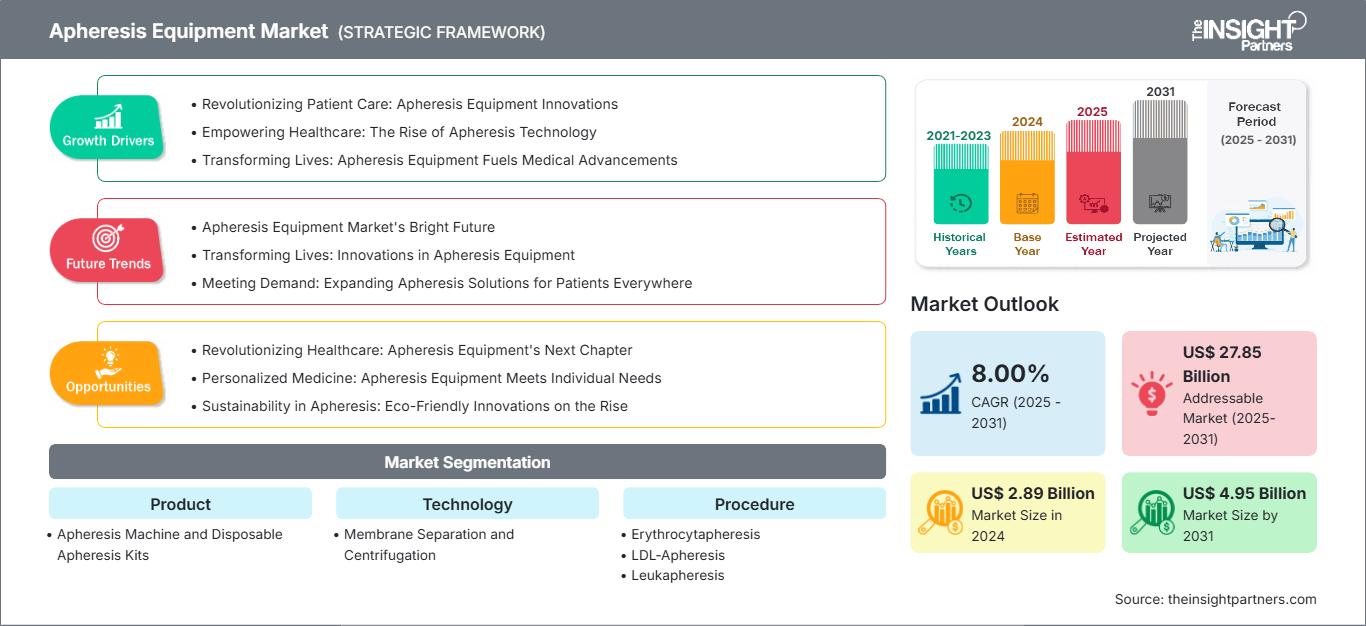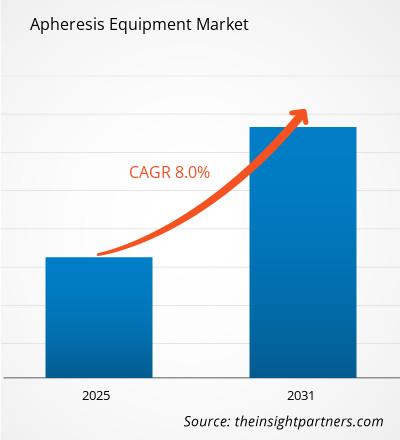Si prevede che il mercato delle apparecchiature per aferesi registrerà un CAGR dell'8,00% dal 2025 al 2031, con una dimensione del mercato in espansione da 2,89 miliardi di dollari nel 2024 a 4,95 miliardi di dollari entro il 2031.
Il rapporto è suddiviso per prodotto (macchine per aferesi e kit monouso per aferesi) e analizza ulteriormente il mercato in base alla tecnologia (separazione a membrana e centrifugazione). Esamina inoltre il mercato per procedura (eritrocitoaferesi, LDL-aferesi, leucaferesi, fotoferesi, plasmaferesi, piastrinoaferesi) e area terapeutica (malattie renali, ematologia, neurologia, altre applicazioni). Per ciascuno di questi segmenti chiave viene fornita una ripartizione completa a livello globale, regionale e nazionale.
Il rapporto include dimensioni e previsioni di mercato per tutti i segmenti, presentando i valori in dollari statunitensi. Fornisce inoltre statistiche chiave sullo stato attuale del mercato dei principali attori, insieme ad approfondimenti sulle tendenze di mercato prevalenti e sulle opportunità emergenti.
Scopo del rapporto
Il rapporto "Aferesi Attrezzature Mercato" di The Insight Partners mira a descrivere il panorama attuale e la crescita futura, i principali fattori trainanti, le sfide e le opportunità. Ciò fornirà spunti di riflessione a diversi stakeholder aziendali, tra cui:
- Fornitori/produttori di tecnologia: per comprendere le dinamiche di mercato in evoluzione e conoscere le potenziali opportunità di crescita, consentendo loro di prendere decisioni strategiche informate.
- Investitori: per condurre un'analisi completa delle tendenze in merito al tasso di crescita del mercato, alle proiezioni finanziarie del mercato e alle opportunità esistenti lungo la catena del valore.
- Enti di regolamentazione: regolamentano le politiche e le attività di controllo sul mercato con l'obiettivo di ridurre al minimo gli abusi, preservare la fiducia degli investitori e sostenere l'integrità e la stabilità del mercato.
Segmentazione del mercato delle apparecchiature per aferesi
Prodotto
- Macchina per aferesi e kit per aferesi monouso
Tecnologia
- Separazione a membrana e centrifugazione
Procedura
- Eritrocitoaferesi
- LDL-aferesi
- Leucaferesi
- Fotoferesi
- Plasmaferesi
- Piastrinoaferesi
Area terapeutica
- Malattie renali
- Ematologia
- Neurologia
- Altre applicazioni
Riceverai la personalizzazione gratuita di qualsiasi report, incluse parti di questo report, analisi a livello nazionale, pacchetto dati Excel e potrai usufruire di fantastiche offerte e sconti per start-up e università.
Mercato delle apparecchiature per aferesi: approfondimenti strategici

-
Scopri le principali tendenze di mercato di questo rapporto.Questo campione GRATUITO includerà analisi dei dati, che spaziano dalle tendenze di mercato alle stime e alle previsioni.
Fattori di crescita del mercato delle apparecchiature per aferesi
- Rivoluzionare l'assistenza ai pazienti: innovazioni nelle apparecchiature per aferesi
- Potenziare l'assistenza sanitaria: l'ascesa della tecnologia dell'aferesi
- Trasformare le vite: le apparecchiature per aferesi alimentano i progressi medici
Tendenze future del mercato delle apparecchiature per aferesi
- Il futuro luminoso del mercato delle apparecchiature per aferesi
- Trasformare le vite: innovazioni nelle apparecchiature per aferesi
- Soddisfare la domanda: ampliare le soluzioni di aferesi per i pazienti di tutto il mondo
Opportunità di mercato per le apparecchiature di aferesi
- Rivoluzionare l'assistenza sanitaria: il prossimo capitolo delle apparecchiature per aferesi
- Medicina personalizzata: le apparecchiature per aferesi soddisfano le esigenze individuali
- Sostenibilità nell'aferesi: innovazioni ecocompatibili in aumento
Approfondimenti regionali sul mercato delle apparecchiature per aferesi
Le tendenze e i fattori regionali che hanno influenzato il mercato delle apparecchiature per aferesi durante il periodo di previsione sono stati ampiamente spiegati dagli analisti di The Insight Partners. Questa sezione illustra anche i segmenti e la distribuzione geografica del mercato delle apparecchiature per aferesi in Nord America, Europa, Asia-Pacifico, Medio Oriente e Africa, America Meridionale e Centrale.
Ambito del rapporto di mercato delle apparecchiature per aferesi
| Attributo del report | Dettagli |
|---|---|
| Dimensioni del mercato nel 2024 | 2,89 miliardi di dollari USA |
| Dimensioni del mercato entro il 2031 | 4,95 miliardi di dollari USA |
| CAGR globale (2025 - 2031) | 8,00% |
| Dati storici | 2021-2023 |
| Periodo di previsione | 2025-2031 |
| Segmenti coperti |
Per prodotto
|
| Regioni e paesi coperti |
America del Nord
|
| Leader di mercato e profili aziendali chiave |
|
Densità degli operatori del mercato delle apparecchiature per aferesi: comprendere il suo impatto sulle dinamiche aziendali
Il mercato delle apparecchiature per aferesi è in rapida crescita, trainato dalla crescente domanda degli utenti finali, dovuta a fattori quali l'evoluzione delle preferenze dei consumatori, i progressi tecnologici e una maggiore consapevolezza dei benefici del prodotto. Con l'aumento della domanda, le aziende stanno ampliando la propria offerta, innovando per soddisfare le esigenze dei consumatori e sfruttando le tendenze emergenti, alimentando ulteriormente la crescita del mercato.

- Ottieni una panoramica dei principali attori del mercato delle apparecchiature per aferesi
Punti di forza chiave
- Copertura completa: il rapporto copre in modo completo l'analisi di prodotti, servizi, tipologie e utenti finali del mercato delle apparecchiature per aferesi, fornendo un panorama olistico.
- Analisi degli esperti: il rapporto è redatto sulla base della conoscenza approfondita di esperti e analisti del settore.
- Informazioni aggiornate: il rapporto garantisce la pertinenza aziendale grazie alla copertura delle informazioni più recenti e delle tendenze dei dati.
- Opzioni di personalizzazione: questo report può essere personalizzato per soddisfare le esigenze specifiche del cliente e adattarsi in modo appropriato alle strategie aziendali.
Il rapporto di ricerca sul mercato delle apparecchiature per aferesi può quindi contribuire a tracciare un percorso di decodificazione e comprensione dello scenario del settore e delle prospettive di crescita. Sebbene possano esserci alcune valide preoccupazioni, i vantaggi complessivi di questo rapporto tendono a superare gli svantaggi.
- Analisi storica (2 anni), anno base, previsione (7 anni) con CAGR
- Analisi PEST e SWOT
- Valore/volume delle dimensioni del mercato - Globale, Regionale, Nazionale
- Industria e panorama competitivo
- Set di dati Excel
Report recenti
Testimonianze
Motivo dell'acquisto
- Processo decisionale informato
- Comprensione delle dinamiche di mercato
- Analisi competitiva
- Analisi dei clienti
- Previsioni di mercato
- Mitigazione del rischio
- Pianificazione strategica
- Giustificazione degli investimenti
- Identificazione dei mercati emergenti
- Miglioramento delle strategie di marketing
- Aumento dell'efficienza operativa
- Allineamento alle tendenze normative






















 Ottieni un campione gratuito per - Mercato delle attrezzature per aferesi
Ottieni un campione gratuito per - Mercato delle attrezzature per aferesi